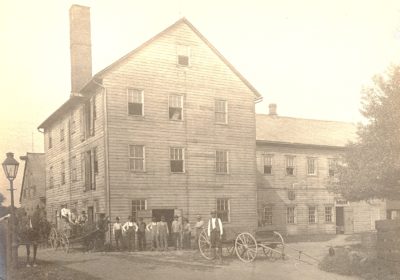Harmony Society (Rappites)
![]()
New Harmony, Indiana
Religious, Christian
Celibate
Communal Property
1805 - 1905

New Harmony, Indiana
Religious, Christian
Celibate
Communal Property
1805 - 1905
1 Dining Room 2 Kitchen 3 Classroom 4 Assembly Hall 5 Dormitory 6 Teacher Room
![Rappite Community House No.2. Plan: Drawn from IN Survey HABS IN-5. Library of Congress]()
The Harmony Society, led by George Rapp, was a group of religious separatists that arrived in the US in 1805, fleeing religious persecution in Germany. Unlike the Moravians, their goal was not conversion or evangelism, but they did hope to lead by example and to demonstrate “the marvel of communal life.” Communalism arose from their religious beliefs and the hardship of living in the American frontier. The group became celibate in 1807 and lived in communal dormitories. The Community House was one of four large dormitories for men and women. After New Harmony was sold to Robert Owen, the building was used as a school and dormitory.
The Rappites built sturdy, stone and brick towns that were pre-planned and built to last. Their second town, New Harmony, they sold to Robert Owen in 1825. Their third and final village was Economy, built on the Ohio River in Pennsylvania. The aging population of Rappites employed outsiders as laborers and educated their children. In 1906 the “Harmony Society” was officially liquidated by the last three Rappites, 100 years after its foundation.

The Harmony Society, led by George Rapp, was a group of religious separatists that arrived in the US in 1805, fleeing religious persecution in Germany. Unlike the Moravians, their goal was not conversion or evangelism, but they did hope to lead by example and to demonstrate “the marvel of communal life.” Communalism arose from their religious beliefs and the hardship of living in the American frontier. The group became celibate in 1807 and lived in communal dormitories. The Community House was one of four large dormitories for men and women. After New Harmony was sold to Robert Owen, the building was used as a school and dormitory.
The Rappites built sturdy, stone and brick towns that were pre-planned and built to last. Their second town, New Harmony, they sold to Robert Owen in 1825. Their third and final village was Economy, built on the Ohio River in Pennsylvania. The aging population of Rappites employed outsiders as laborers and educated their children. In 1906 the “Harmony Society” was officially liquidated by the last three Rappites, 100 years after its foundation.



Rappites End Notes
“Rappite Community House No. 2 in New Harmony, Indiana.” CONTENTdm. Accessed November 24, 2021. https://digitalarchives.usi.edu/digital/collection/RLIC/id/25617/.